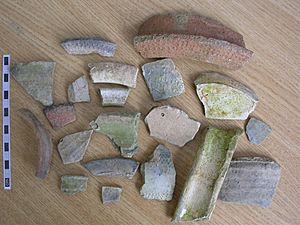Stamford ware facts for kids

Stamford ware is a special type of pottery made a long time ago in England. It was one of the first kinds of pottery to have a shiny, clear coating called a glaze. This pottery was made in a town called Stamford in England. People made it there for a long time, from the 800s to the 1200s.
Stamford ware was very popular and was traded far and wide across Britain and even to nearby countries. The most common things made from this pottery were jugs, pitchers with spouts, and small bowls. Because it was found in so many different places, historians can use Stamford ware to understand old trade routes. These were like ancient highways for buying and selling goods.
What is Stamford Ware?
Stamford ware is a type of earthenware, which means it's made from clay and then baked. What makes it special is its lead glaze. This glaze is a thin, clear layer that makes the pottery shiny and waterproof. It was one of the first times this kind of glaze was used in England.
How Was It Made?
The glaze was put on the pottery with a brush. The color of the glaze could be pale yellow, orange, light green, or even a smoky blue. The final color depended on a few things. These included what the glaze was made of, how much iron was in the clay, and how the pottery was baked in the kiln.
Early Stamford glazes were unique because they had tiny bits of silver in them, but no tin. This made them different from other glazes used at the time.
Where Can You See It?
If you want to see real pieces of Stamford ware, you can visit the Stamford Museum. There are also examples in other museums around the country.
Discovering Stamford Ware
People first found greenish Anglo-Saxon pottery in Stamford in 1950. This discovery showed that lead glaze was being used very early on. Later, in 1963, a medieval kiln (a special oven for baking pottery) was found at Stamford School. Then, in 1976, an even older kiln was discovered at Stamford Castle. These finds helped experts learn more about how and where Stamford ware was made.

